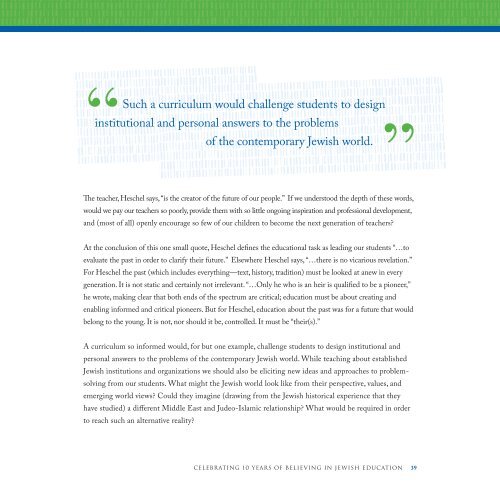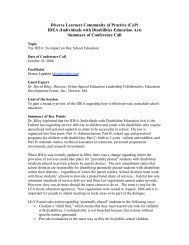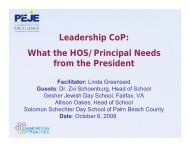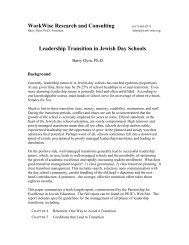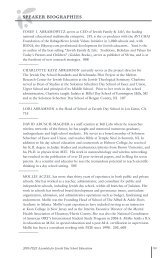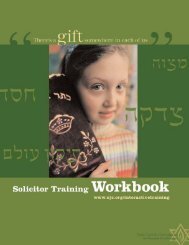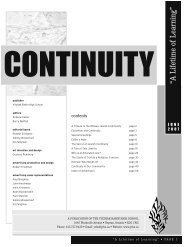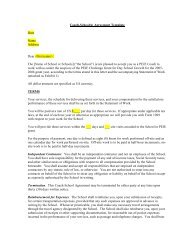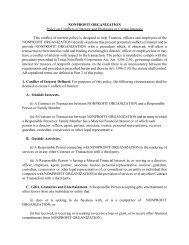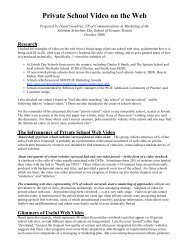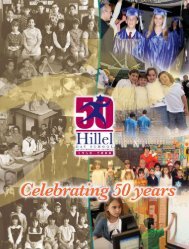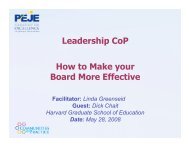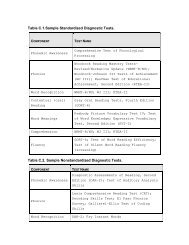10 Years of Believing in Jewish Day School Education
10 Years of Believing in Jewish Day School Education
10 Years of Believing in Jewish Day School Education
Create successful ePaper yourself
Turn your PDF publications into a flip-book with our unique Google optimized e-Paper software.
“<br />
Such a curriculum would challenge students to design<br />
<strong>in</strong>stitutional and personal answers to the problems<br />
”<br />
<strong>of</strong> the contemporary <strong>Jewish</strong> world.<br />
The teacher, Heschel says, “is the creator <strong>of</strong> the future <strong>of</strong> our people.” If we understood the depth <strong>of</strong> these words,<br />
would we pay our teachers so poorly, provide them with so little ongo<strong>in</strong>g <strong>in</strong>spiration and pr<strong>of</strong>essional development,<br />
and (most <strong>of</strong> all) openly encourage so few <strong>of</strong> our children to become the next generation <strong>of</strong> teachers?<br />
At the conclusion <strong>of</strong> this one small quote, Heschel def<strong>in</strong>es the educational task as lead<strong>in</strong>g our students “…to<br />
evaluate the past <strong>in</strong> order to clarify their future.” Elsewhere Heschel says, “…there is no vicarious revelation.”<br />
For Heschel the past (which <strong>in</strong>cludes everyth<strong>in</strong>g—text, history, tradition) must be looked at anew <strong>in</strong> every<br />
generation. It is not static and certa<strong>in</strong>ly not irrelevant. “…Only he who is an heir is qualified to be a pioneer,”<br />
he wrote, mak<strong>in</strong>g clear that both ends <strong>of</strong> the spectrum are critical; education must be about creat<strong>in</strong>g and<br />
enabl<strong>in</strong>g <strong>in</strong>formed and critical pioneers. But for Heschel, education about the past was for a future that would<br />
belong to the young. It is not, nor should it be, controlled. It must be “their(s).”<br />
A curriculum so <strong>in</strong>formed would, for but one example, challenge students to design <strong>in</strong>stitutional and<br />
personal answers to the problems <strong>of</strong> the contemporary <strong>Jewish</strong> world. While teach<strong>in</strong>g about established<br />
<strong>Jewish</strong> <strong>in</strong>stitutions and organizations we should also be elicit<strong>in</strong>g new ideas and approaches to problemsolv<strong>in</strong>g<br />
from our students. What might the <strong>Jewish</strong> world look like from their perspective, values, and<br />
emerg<strong>in</strong>g world views? Could they imag<strong>in</strong>e (draw<strong>in</strong>g from the <strong>Jewish</strong> historical experience that they<br />
have studied) a different Middle East and Judeo-Islamic relationship? What would be required <strong>in</strong> order<br />
to reach such an alternative reality?<br />
Celebrat<strong>in</strong>g <strong>10</strong> years <strong>of</strong> believ<strong>in</strong>g <strong>in</strong> <strong>Jewish</strong> <strong>Education</strong> 39


